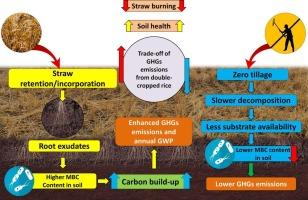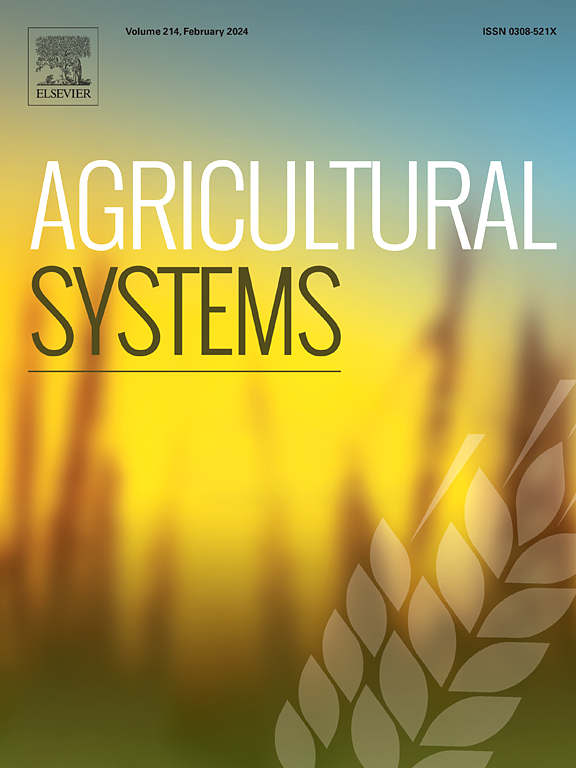稻草保留和零耕作法双季稻温室气体排放的权衡
IF 6.1
1区 农林科学
Q1 AGRICULTURE, MULTIDISCIPLINARY
引用次数: 0
摘要
背景为遏制秸秆焚烧的威胁和维持水稻生产系统的土壤健康,人们大规模地采用了零耕作和秸秆保留。与此同时,我们知道水稻种植,尤其是双季稻种植系统,是大气温室气体(GHGs)的人为排放源,主要是甲烷(CH4)、氧化亚氮(N2O)和二氧化碳(CO2)。因此,了解秸秆保留和零耕地如何影响水稻-水稻系统中的温室气体排放非常重要。目的通过本研究,我们努力评估秸秆保留/焚烧和零耕地(ZT)做法对水稻温室气体排放、产量和土壤易变碳库的影响,以确定可减少温室气体排放、改善土壤健康并同时解决秸秆焚烧问题的可持续做法。方法进行了为期两年的田间研究,共采用了四种(04)处理方法:(i) 前茬作物收割后立即将稻草掺入(IIRS);(ii) 喷洒草甘膦的零耕(稻草保留)(ZT);(iii) 在田间撒播稻草(SRS);(iv) 不喷洒草甘膦的零耕(稻草保留)(ZT + SR)。结果和结论在稻草分解期和水稻生长期,IIRS 的平均季节性甲烷(CH4)、氧化亚氮(N2O)和二氧化碳(CO2)排放量和全球变暖潜势(GWP)明显高于 SRS、ZT 和 ZT + SR,其次是 SRS。同样,与其他处理相比,IIRS 的土壤可变碳库和酶活性也更高。此外,从初始到最终的 SOC 增加百分比,IIRS 较高(25.8%),其次是 SRS(23.3%)、ZT(20.7%)和 ZT + SR(17.9%)。然而,秸秆掺入/保留和耕作方法对作物产量的影响并不明显。由此可见,在零耕作(ZT)和秸秆保留/融入耕作法中,土壤碳改善和温室气体排放之间存在权衡。秸秆保留/掺入土壤一方面增加了碳储存,但同时也增加了温室气体排放。该研究确定了零耕作(秸秆保留)和不喷洒草甘膦的秸秆保留(ZT + SR)可用于可持续秸秆管理,在解决秸秆焚烧问题的同时,增加了碳积累,减少了温室气体排放。本文章由计算机程序翻译,如有差异,请以英文原文为准。

Trade-off of greenhouse gas emissions from double-cropped rice due to straw retention and zero tillage practices
CONTEXT
Zero tillage and straw retention have been presented large scale to curb the menace of straw burning and sustaining soil health in rice production systems. At the same time, we know rice cultivation particularly double rice cropping system is an anthropogenic source of atmospheric greenhouse gas (GHGs) emissions, mainly, Methane (CH4), Nitrous oxide (N2O), and Carbon dioxide (CO2). Thus, it is important to know how straw retention and zero tillage affect the GHGs emissions in the rice-rice system.
OBJECTIVE
The study, we made an effort to assess the straw retention/incorporation and zero-tillage (ZT) practices on GHGs emissions, yield, and soil labile carbon pools in rice, to identify sustainable practices that reduce GHG emissions, improve soil health, and at the same time addresses the issue of straw burning.
METHODS
A two-year field study was conducted with four (04) treatments; (i) Immediate incorporation of rice straw after harvesting of previous crop (IIRS); (ii) Zero-tillage (with straw retention) with glyphosate spray (ZT); (iii) Spreading of rice straw over field (SRS); and (iv) Zero-tillage (with straw retention) without glyphosate application (ZT + SR). The GHGs fluxes were measured during both straw decomposition (before rice transplanting) as well as rice growing periods during both wet and dry seasons of the two consecutive years.
RESULTS AND CONCLUSIONS
The average seasonal Methane (CH4), Nitrous oxide (N2O), and Carbon dioxide (CO2) emissions and global warming potential (GWP) were significantly higher in IIRS followed by SRS, ZT, and ZT + SR during straw decomposition as well as rice growing periods. Similarly, the soil labile carbon pools and enzymatic activities were also higher in IIRS as compared to other treatments. Moreover, the increased percentage of SOC from initial to final was higher in IIRS (25.8 %), followed by SRS (23.3 %), ZT (20.7 %), and ZT + SR (17.9 %). However, the crop yield was not significantly influenced by the straw incorporation/retention and tillage practices. So, it is evident there is a trade-off of soil carbon improvement & GHGs emissions in zero tillage (ZT) and straw retention/ incorporation practices. Straw retention/incorporation in soil on one hand increased carbon storage but at the same time also enhanced GHGs emissions. Zero tillage (with straw retention) without glyphosate spray could be recommended for sustainable straw management.
SIGNIFICANCE
The study identifies zero-tillage with straw retention without glyphosate spray (ZT + SR) for sustainable straw management, which increases the carbon build-up and decreases the GHGs emissions while addressing the issue of straw burning.
求助全文
通过发布文献求助,成功后即可免费获取论文全文。
去求助
来源期刊

Agricultural Systems
农林科学-农业综合
CiteScore
13.30
自引率
7.60%
发文量
174
审稿时长
30 days
期刊介绍:
Agricultural Systems is an international journal that deals with interactions - among the components of agricultural systems, among hierarchical levels of agricultural systems, between agricultural and other land use systems, and between agricultural systems and their natural, social and economic environments.
The scope includes the development and application of systems analysis methodologies in the following areas:
Systems approaches in the sustainable intensification of agriculture; pathways for sustainable intensification; crop-livestock integration; farm-level resource allocation; quantification of benefits and trade-offs at farm to landscape levels; integrative, participatory and dynamic modelling approaches for qualitative and quantitative assessments of agricultural systems and decision making;
The interactions between agricultural and non-agricultural landscapes; the multiple services of agricultural systems; food security and the environment;
Global change and adaptation science; transformational adaptations as driven by changes in climate, policy, values and attitudes influencing the design of farming systems;
Development and application of farming systems design tools and methods for impact, scenario and case study analysis; managing the complexities of dynamic agricultural systems; innovation systems and multi stakeholder arrangements that support or promote change and (or) inform policy decisions.
 求助内容:
求助内容: 应助结果提醒方式:
应助结果提醒方式:


